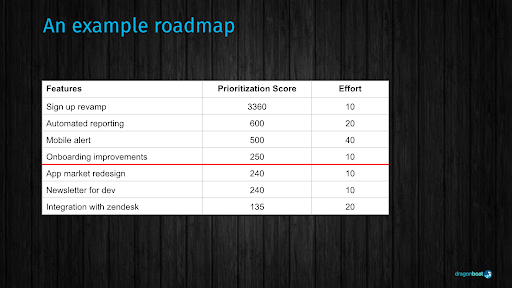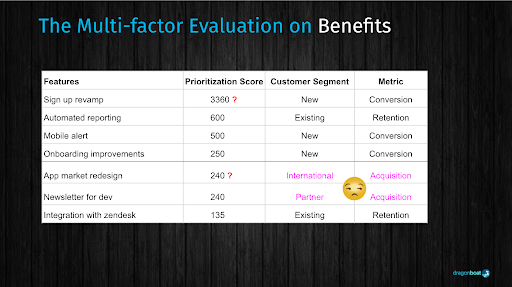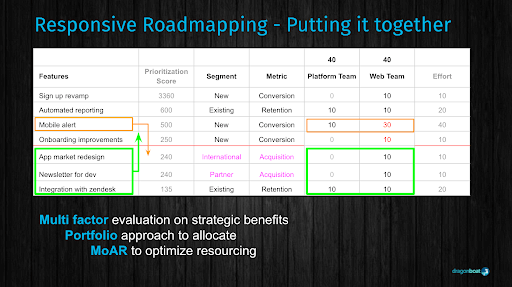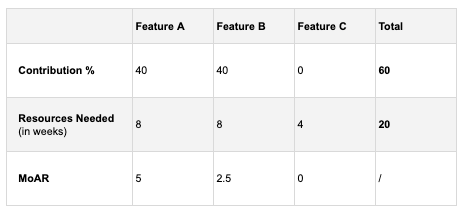When faced with hundreds of feature ideas and requests, prioritization can seem like an impossible task. How do you decide between customer needs and business goals? Not only is there that initial trade-off, but within each dimension of the puzzle there are additional trade-offs like different types of customers and multiple overarching goals.
Product management is a juggling act where success requires working across multiple dimensions to achieve both customer delight and a company’s business goals. So how do you prioritize product initiatives within this sea of factors? Traditionally, the key measurement was ROI, but there has been a shift to more in-depth dynamic scoring strategies such as RICE and MoSCow. Even these, though, don’t connect the dots between business goals and product strategies.
I believe that MoAR, Metrics over Available Resources, is the most effective measure of product prioritization, especially when used alongside portfolio allocation. Here’s why.
ROI fails to capture innovation
ROI is a flawed prioritization metric because it’s difficult to attribute product features to revenue fast enough (especially in an agile environment) to influence the prioritization of your product’s next iteration. A monetary-based benefit can also lead to negative bias against innovation and risk-taking. In the short-term, the same investment in an existing revenue-generating channel will always generate a higher ROI than new, untested products.
A great example of ROI stifling innovation is outlined in the podcast “What Really Happened When Ebay Went To China” where Alan Tien, the former GM of PayPal China, highlights how difficult it was to justify R&D investment to improve the product in China since it was the smaller market at the time.
In terms of “investment,” not all money is created equal. Money does not get you the engineers you need now. iOS engineers can’t do data science engineering work.
Taking a pure “return on investment” approach won’t give you the ultimate benefits of each product/feature, the output relative to resources, or outcomes that aren’t monetary.
If not ROI, then what?
Scores like RICE, MoSCow, and Kano have gained popularity as an alternative to ROI. While they are good for measuring customer impact, they provide a singular view into prioritization without context of business impact and company priorities.
The example below shows how many teams use one of these models to prioritize: They score features, add up effort needs, and draw a cut line where everything below the line is automatically dropped.

How do you connect these features to goals or strategic intent? Adding additional dimensions to the plan gives you visibility into how you’re allocating resources across different segments, areas, teams, and company goals. This next step is a critical measure because it allows you to evaluate prioritization decisions based on a variety of metrics most important to the company’s success, i.e. conversion vs. retention.
In the chart below, by adding customer segment and metric, we now see that in our original prior prioritization exercise, although we picked the highest scores, we were missing key information around allocation. We had no features focused on international or partner segments and we had no features focused on driving acquisition.

Finally, looking at segment, metric, and effort, and adding resourcing needs, we’re able to see a full picture to effectively plan our roadmap. We can now make informed data-driven decisions based on predetermined allocations and existing resourcing needs. In this case, by moving app market redesign, newsletter for dev, and integration with Zendesk, we’re able to build features for all segments and metrics, while leveraging the same amount of resources.

This is called MoAR (Metrics Over Available Resources). To see the full picture, product leaders must look at metrics across the product and portfolio relative to available resources.
How MoAR works
Metrics Over Available Resources (MoAR) is the ratio of contribution of a product feature towards a metric used to measure a business outcome, over the number of resources needed to achieve this contribution.
MoAR maps to the company goals and strategies, accounts for immediate resourcing needs, and allows product leaders to plan based on dynamic metrics. Metrics, such as retention or conversion, can be agreed upon and measured in a timeframe relative to the forecasted outcome.
Example metrics could include user growth, referral rate, retention, NPS, and other direct measures of product benefits. They are often leading indicators of future monetary returns. Companies that adopt a goal framework such as OKRs can also connect these outcome targets with product portfolio roadmapping.
The “Available Resources“ part of MoAR accounts for scarcity of resources. For example, a Scala Engineer should be treated differently than the UX designer who designed the last iteration.
MoAR enables outcome-driven product teams
During portfolio roadmap planning, you can use MoAR to prioritize and compare features that require the same resources. MoAR helps provide an indication on prioritization and the likelihood of achieving the goal.
For example, assume a key business goal for the next quarter is to increase conversion by 10%. The team has to choose between three features and there are only 16 weeks of front-end resources available.
- Feature A is expected to contribute to 40% of this goal and requires eight weeks of front-end resources. The MoAR for Feature A is 40/8 = 5
- Feature B may add to 20% of this goal and requires eight weeks of front-end resources. The MoAR for Feature B is 20/8 = 2.5
- Feature C contributes to a cost-saving metric, but not towards the conversion goal, and requires four weeks of front end resources. Thus, the MoAR for Feature C is 0.

This simple calculation allows us to immediately de-prioritize Feature C as its MoAR is 0. We can also now identify there is an outcome gap: Feature A and B will only contribute to 60% of the target metric. The team needs to either reduce the target outcome by 40% and get stakeholder buy-in, or start over to design a different feature set to achieve 100% of the target.
MoAR arms product leaders with the insights they need to proactively address gaps, allocate resources, and plan roadmaps based on outcomes. Because even though A > B > C, B + C could still be > A.
By taking a portfolio approach to product management, companies can drive better product decisions, visualize product portfolio metrics, and create an outcome-focused product organization.
—
Want to build products that achieve both near-term results and long-term vision? Sign up for a 14-day free trial of dragonboat to build an outcome-focused product strategy leveraging MoAR.

